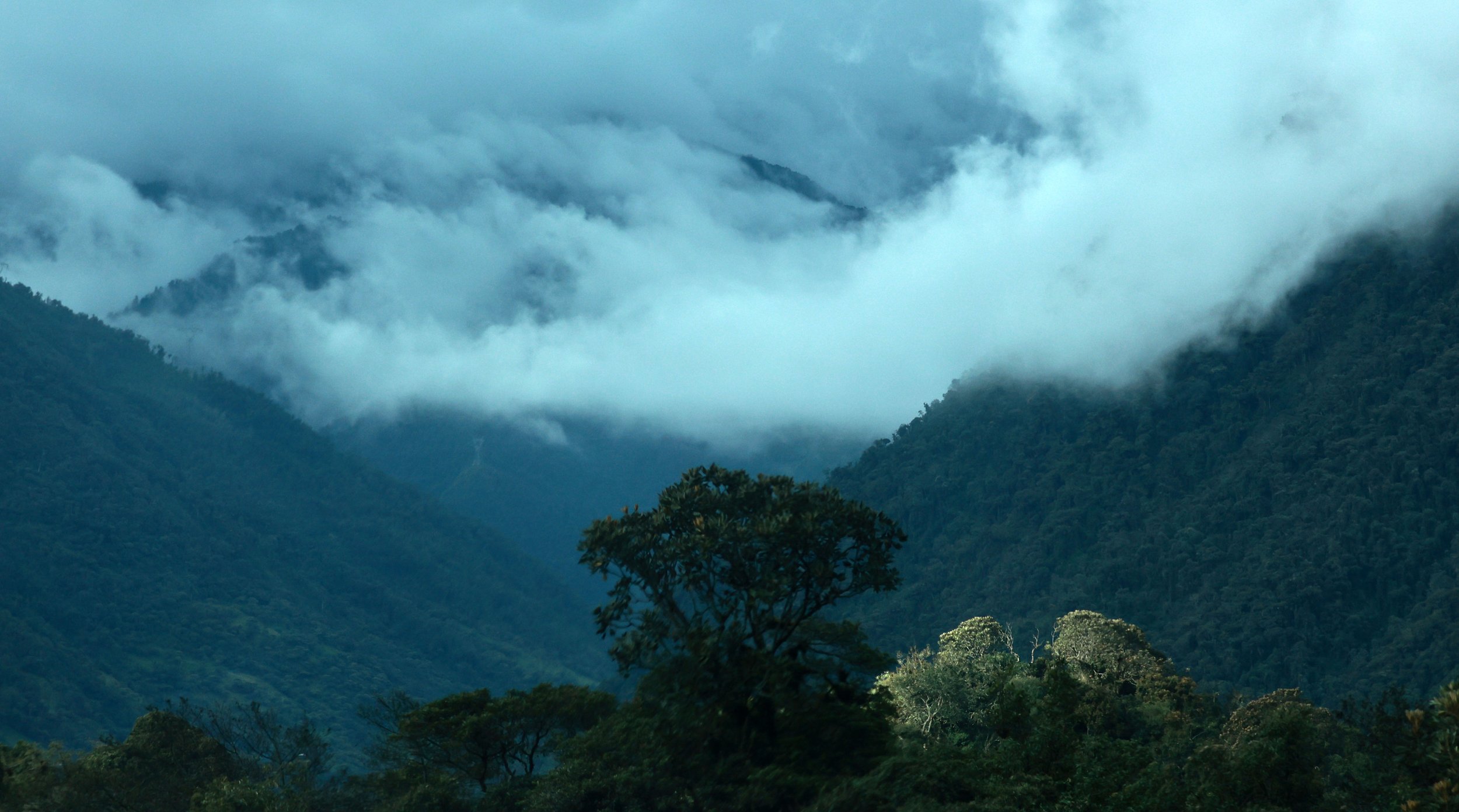
Ecuadorian Andes
Routing for the six-day expedition to Ecuadorian Andes
Segment Three of the Great Primate Safari of 2023
(21 - 26 July 2023)
After nearly a month in Brazil, Ecuador was my next destination for the Great Primate Safari of 2023. While I definitely had targets in Ecuador, actually only one or two were primates interestingly. My main targets were Spectacled Bear and Mountain Tapir, both of which ended up being quite easy, although neither were guaranteed.
From Manaus, the second leg of the expedition, I flew to Sao Paulo to Santiago to Lima to Quito in a marathon 17 hours of grueling zero legroom flights…. But as was the case for all of my flights for the entire 54 days of the expedition (and there were a lot of them!), all were uneventful AND on time! Wrap your head around that for a bit….
Here are links to other segments of the “Great Primate Safari of 2023”:
Brazilian Cerrado and Pantanal
Link to complete species list for the “Great Primate Safari of 2023”
In Quito was met by my guide and friend, Luis Perez, an outstanding birding guide who freelances but in this case was contracted by Xavier Munoz the owner of Neblina Forest Birding Tours to guide me to several locations in search of my targets and more. This was my 7th or 8th time landing in Quito, which for anyone who has done this knows, is a spectacular place to see from the air. My approach to the city was on a spectacularly clear day with visuals of at least five volcanoes as well as the city itself. Absolutely spectacular.
Bellavista Cloud Forest Lodge
My first segment of this trip was up to the spectacular Bellavista Cloud Forest Lodge, about three hours or less from Quito. The drive takes us through the Western Andes Choco ecosystems, which are simply outstanding. The mosses, lichens and spectacular orchids and bromeliads are such a special and unique ecosystem with unfathomable biodiversity. After the utter humidity of Manaus, it was very nice to get into some higher elevations and cooler weather.
Now my stay at Bellavista was to be a short one. In fact, my entire expedition to Andean Ecuador was short – too short, but it was designed to make my six-night, six days as productive as possible by choosing the best locations for my targets while minimizing travel times. But when you have limited time like I did on this trip, there is always a risk of dipping on your targets – the rule of thumb is always give yourself more time in a location than you think you might need. I had only one night at Bellavista sadly. However, this short afternoon and one morning time period proved to be insanely productive.
On top of seeing dozens of species of amazing birds, the toucanets and tanagers standing out for me, I was able to get outstanding views of Tayra, Western Red-tailed Squirrels and Kinkajou. The lodge is famous for Olinguito but I did not see one sadly. And for those hoping to see one there, the local in-house guides estimated one comes into the feeders seven out of ten nights or about 70% chance.
Without a doubt, my highpoint was a Spectacled Bear that came into the lodge’s compost pile down the main trail into the forest from the lodge. This species was in the top five targets for me on this expedition.
We started down the trail before dark intending to stake out the compost pile as a family of Spectacled Bears had been seen there regularly for a couple weeks. Amazingly, we spotted a large young bear immediately upon arriving at the pile! It was simply there right in front of us! Frustratingly the light was so poor, the first burst of images I snapped were awful. Luckily the bear was fearless of us and was in no hurry to go anywhere at all, so I was able to wait for quite some time for the light to improve.
While I was waiting for better light, I was reveling in the realization that I was now a member of a VERY exclusive club – the “All the Bears of the World Club”! With this new lifer under my belt, I now had every species of bear on earth seen and photographed in their own habitat. I am not sure how many people can actually say this….
We had outstanding views for over an hour at least. The area was actually quite cramped along the trail with a steep slope up AND down from the trail. And this bear was very curious of us. He came up the trail to investigate us and tried to approach us at very close distances. And I mean very close – too close for comfort for sure. On at least two occasions we were absolutely trapped on the trail, with the bear on one end – the exit end – and us on the end that headed deeper into the forest. We were at an impasse! HE was not going to budge, and we had no place to go. After some mock charges by us along with some grunts and snorts with hands held high, he eventually gave us some space by climbing up a tree. At the end of it all we never really felt scared as he was not exactly aggressive, but a bear of that size could do serious damage simply by being curious.
Links:
Western Red-tailed Squirrels were also very common at the Bellavista Cloud Forest Lodge
Spectacled Bear seen along the forest trail at Bellavista Cloud Forest Lodge
Spectacled Bear guarding the trail
The bear reacted to our mock charges by hugging a tree and sometimes climbing up.
Here he comes!
Golden-naped Tanager was one of the many incredible Tanagers at Bellavista
Plate-billed Mountain-Toucan was the show stopper at Bellavista! Wow what a bird!
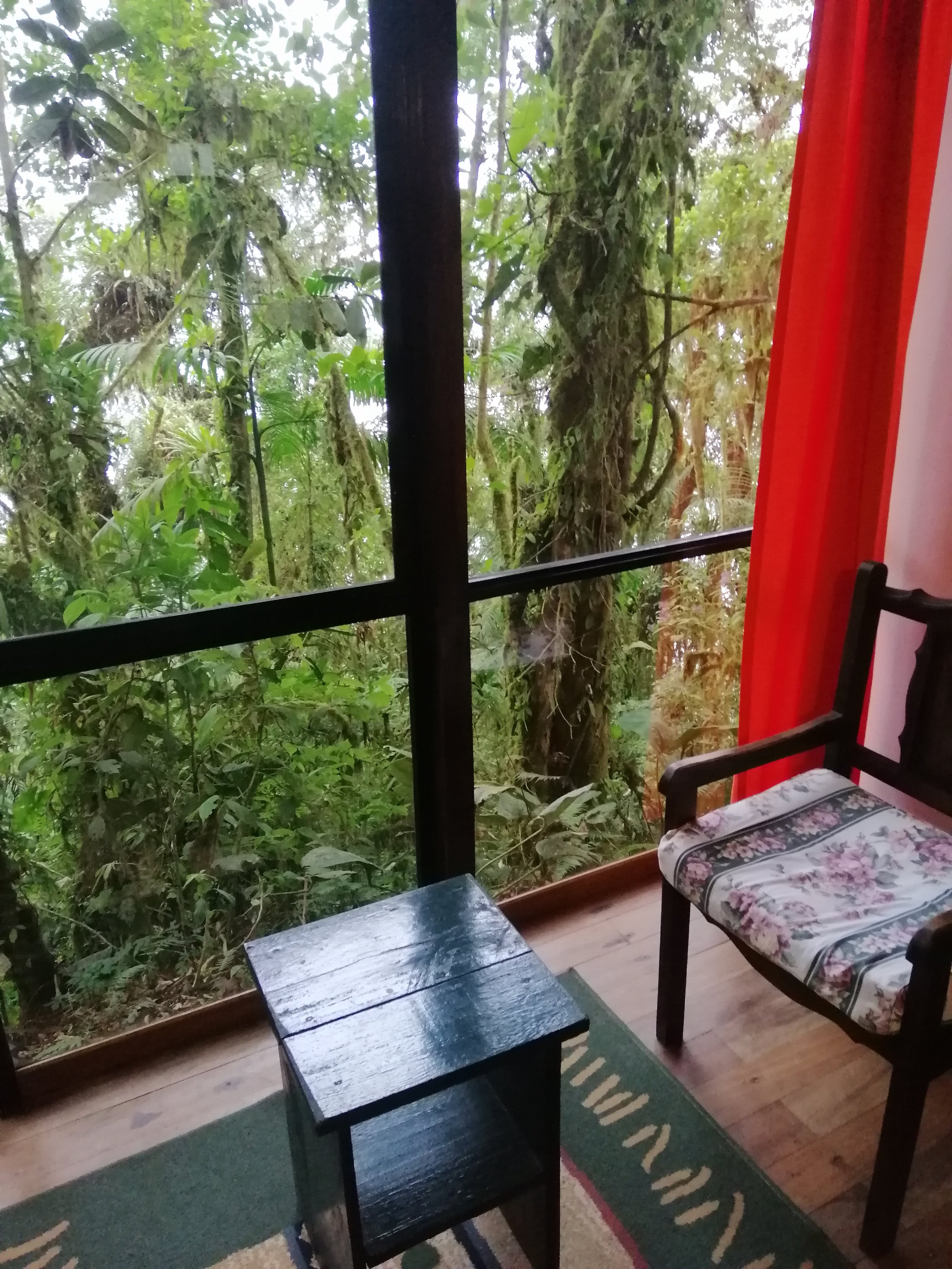
View of the lush cloud forest from my room at Bellavista.

My awesome guide, Luis Perez. Great birding and now a great mammal watching guide!
Mindo
After scouring the Bellavista private reserve (1600 hectares), we made our way through more spectacular Choco Western Andean scenery to the town of Mindo where we spent some time at some amazing bird feeders shooting for views of Central American Agoutis, not quite a lifer for me as I had seen them in Panama some years ago. We saw many at the Sachatamia Lodge coming in for kernels of corn that were left for them below the bird feeders, which were also incredibly productive. We stopped at a couple other smaller birding hotspots and saw mainly the same species we’d been seeing all along this day but we did manage some decent but very foggy views of Golden-headed Quetzal, although no decent images came to be.
By this time fatigue and rain was setting in big time and I was ready for an early night. This is a bit unfortunate as Mindo seemed like quite a cool town. It is pretty touristy, but it had a funky vibe about it, and I would not mind spending more time there in the future.
Central American Agouti grooming each other.
Note the seemingly scarred upper lip. It appeared that all of the individuals here had this characteristic. Not sure if it is natural.
Female Red-headed Barbet
Male Red-headed Barbet
Velvet-purple Coronet was the most common hummer in Mindo's feeders
Undoubtedly the most beautiful hummingbird at Minda were the White-booted Racket-tails
Blue-winged Mountain Tanagers were very common at most locations
My only picture of the Golden-headed Quetzal at Mindo.
Mashpi
Our next day was spent further down the road from Mindo to Mashpi where we were hoping to see a Mountain Coati at the home base of Xavier, my host. His private garden and home are very nice and have stunning views of the hills and valleys near and around Mashpi. And he has a Mountain Coati that does come in regularly, but sadly not the day we were there. What we did see was ample amounts of rain, the first serious rain on my expedition in four weeks! In fact, that spell of rain that lasted less than an afternoon was pretty much the only rain during the entire two-month expedition to South America!
So, after a few hours fruitlessly waiting for a Mountain Coati, we did end up seeing more Tayra, Western Red-tailed Squirrels and loads of amazing birds, we opted to head back toward Quito, our ultimate destination for the day, to see a Cock-in-the-Rock lek located in Nanegal, about an hour or more from Mashpi.
Now I had seen Cock-in-the-Rock before in Peru but never got good images. And once again seeing their lek was absolutely stunning. The noise of the lek was dinosauric as we hiked the trail down the valley in Nanegal to the privately owned lek. I could tell I was in for a treat. Once there I witnessed several birds perched quite distant from each other all squawking and flexing to attract a female. While I never did see a female select a male, I did see several males buzz off quickly, so I am assuming they were after a female?
From there we headed back down out of the Western Andes and into Quito where I spent a lovely and incredibly comfortable evening at the airport Holiday Inn. Our next destination was Antisana, one of the gems of the Eastern Andes of Ecuador!
Antisana National Park
The road from Quito to Antisana was pretty rough – a poorly maintained road that serves a massive basalt mine with trucks constantly coming and going. The road does go through some very rustic and cultural areas and towns in this part of Ecuador, so it is very nice to see and travel through. Antisana is the name of the one of the larger volcanoes in Ecuador and luckily it was very clear during our visit because it is simply spectacular.
Our main targets for Antisana were the Andean White-tailed Deer, Andean Fox (=Culpeo) and the Andean Condors that course by the cliff-faces of the region. Our first stop was the Condor Roost, a few kilometers before Antisana National Park entrance. This is a private operation, and you need a local guide and permission to get to the best viewing sites which are several kilometers along a dirt track that ends on top of steep cliffs directly adjacent to two very large Condor roosts.
Once there it did not take long to spot White-tailed Deer, several species of ducks and of course, several Andean Condor! What a sight it was seeing those massive birds glide by us at eye level from the cliff edges where we were situated. It was clear that the Condors as well as other birds of prey were approaching us closely to get better looks at us as well as scouting for prey. Simply an amazing experience which I highly recommend.
From there it is a steep ascent to the altiplano of Antisana National Park which consists of vast grasslands and scrublands where we encountered many herds of Andean White-tailed Deer and some of the highland avifauna. We were constantly searching for Spectacled Bears and Culpeo, both of which were elusive but sometimes seen along this road. Once we arrived at Mirador Laguna dela Mica, a dammed lake at the end of the road in Antisana, we decided to stroll a bit to search for whatever.
Although the scenery was simply unbelievable, I was a bit disappointed that we had not seen a Culpeo yet. This would have been my only and last chance to see this canid on my expedition. We strolled the upper shore of the Laguna scanning the altiplano with no luck. As we basically gave up and started back on the trail, Luis noticed a sleeping Culpeo sleeping low in the grasses quite a bit down the road from where we were! Nice!
Once we got within closer viewing distance, the military guards of the dam told us that we had just missed a kill! The Culpeo attacked and killed a young White-tailed Deer fawn literally five minutes before and was now resting in the grasses before returning to feed. The guards were nice enough to allow me to approach for excellent images of the exhausted Culpeo (the road the fox was on was a private road with no public access normally) …. Simply spectacular!
After a bit more time at Antisana, we began our progression to lower elevations, stopping for some impressive hummingbird viewing along the way. Our destination was Termas Papallacta, located directly behind Mount Antisana from where our day began. This meant returning to Quito and then ascending to Papallacta Pass (4000m+) searching for wildlife along the way. Evidently the road from Quito up to the pass is a good place for Spectacled Bear although we did not see any sign. It is also known for Northern Pudu, and one was seen the day before our arrival…. just not by us. We definitely tried though.
Andean White-tailed Deer fawn killed five minutes prior to this picture being taken.
Female Andean White-tailed Deer frothing in the mouth with stress of having witnessed her fawn being killed by the Culpeo
Andean White-tailed Deer
Culpeo repositioning after I approached
Culpeo giving me the evil eye.
Culpeo
Andean Condor soaring by at eye-level.
Andean Condor
Andean Condor flying below our position.
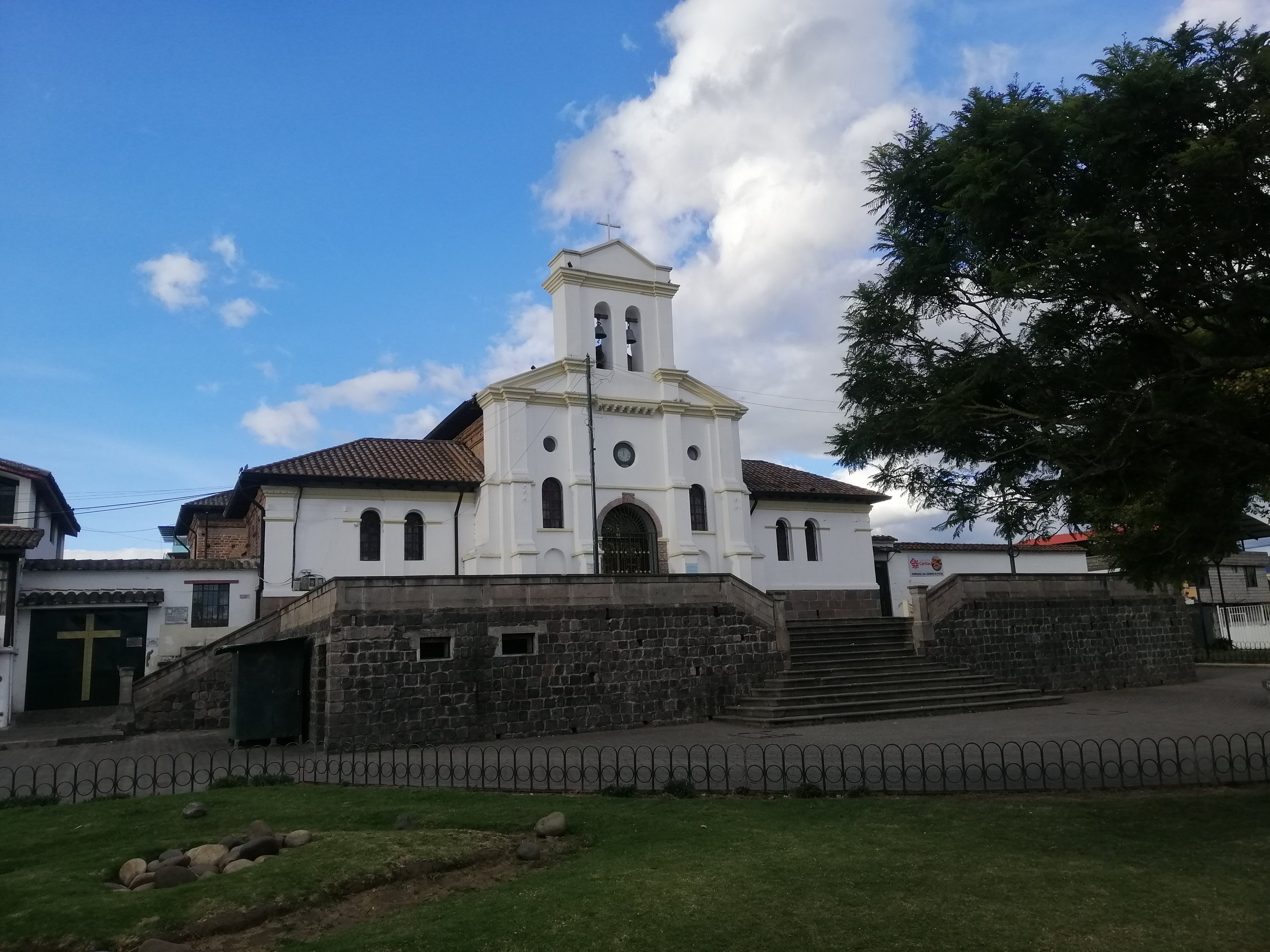
Pintag, Ecuador - on the way to Antisana.
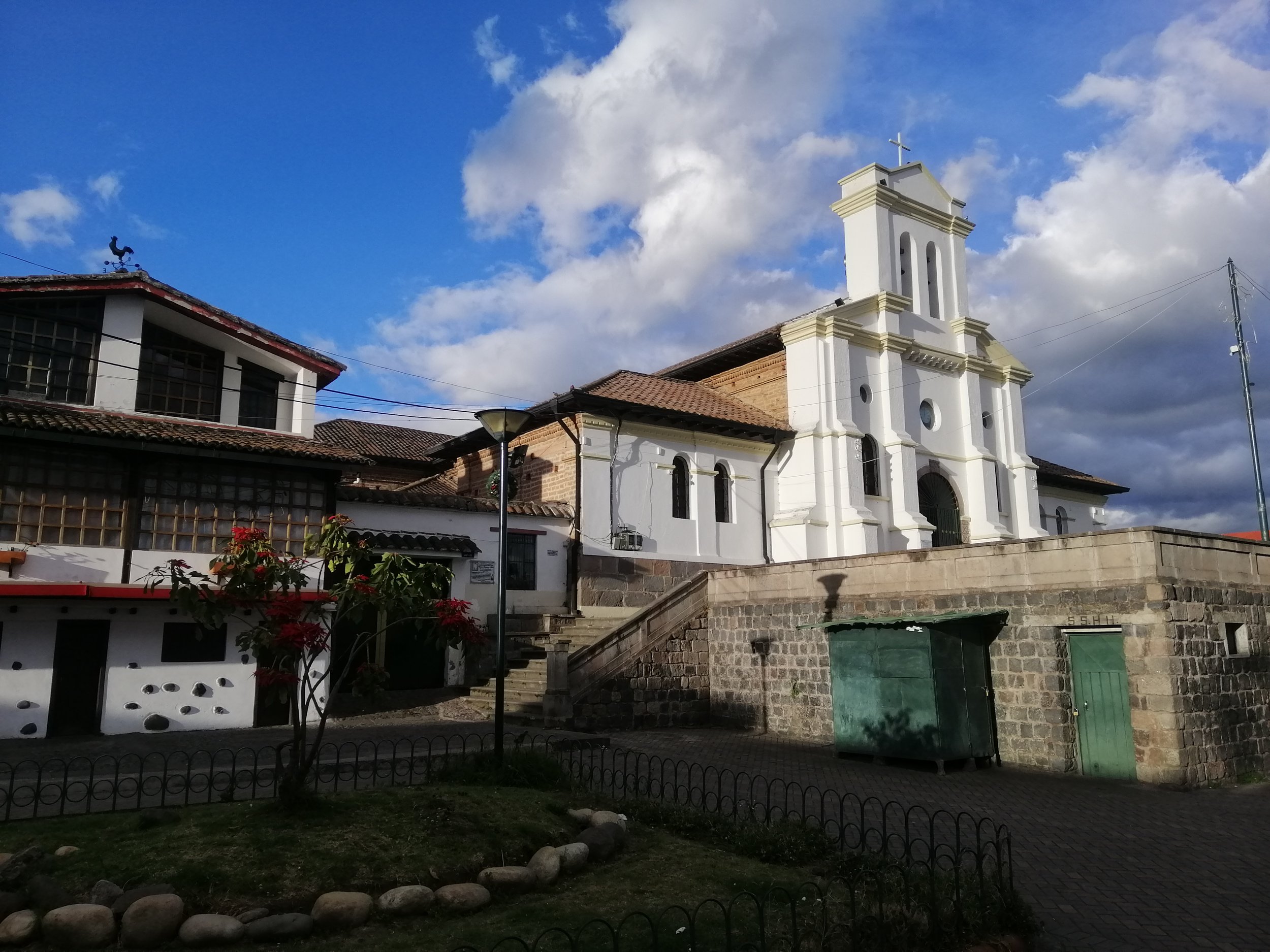
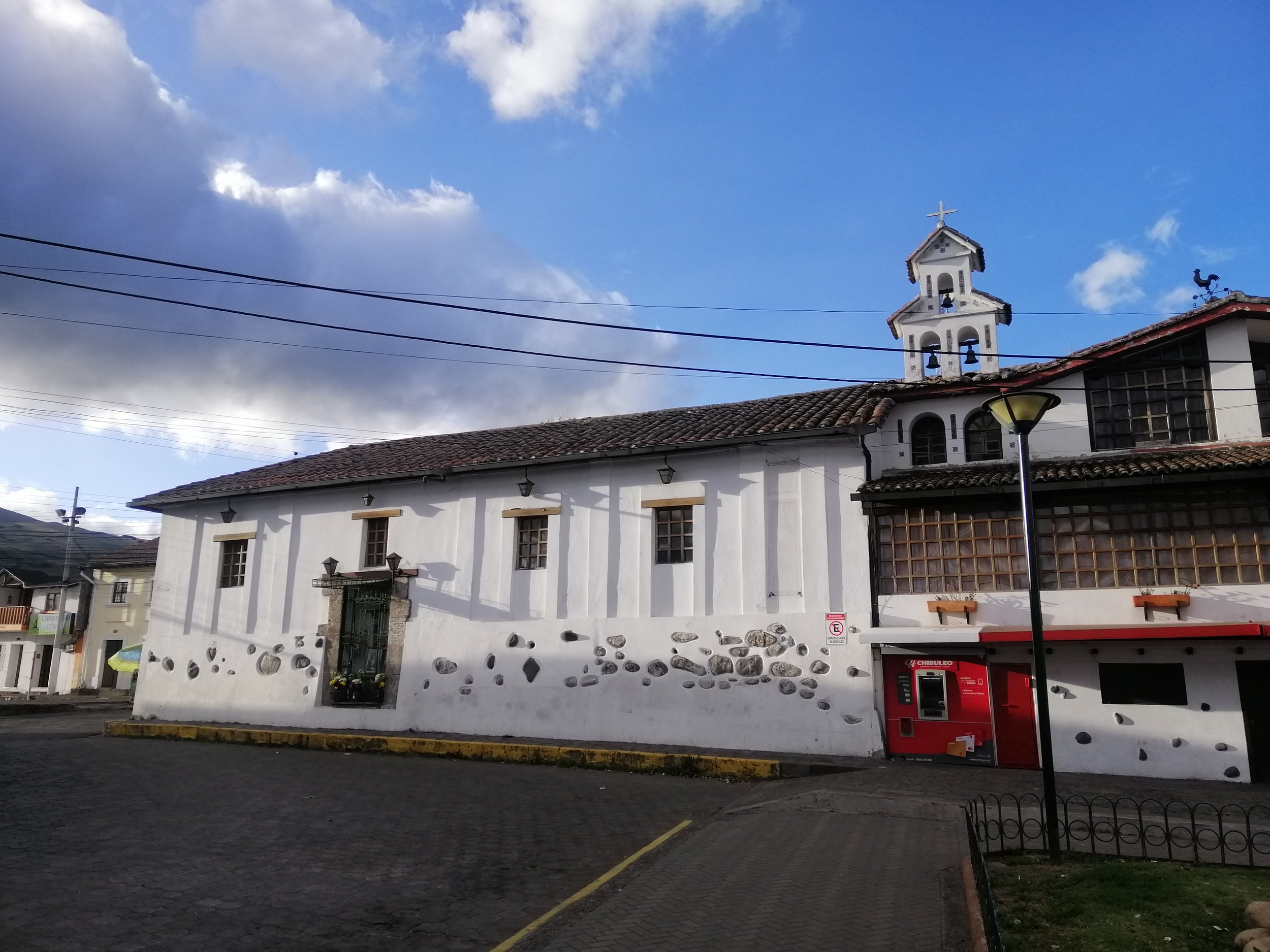
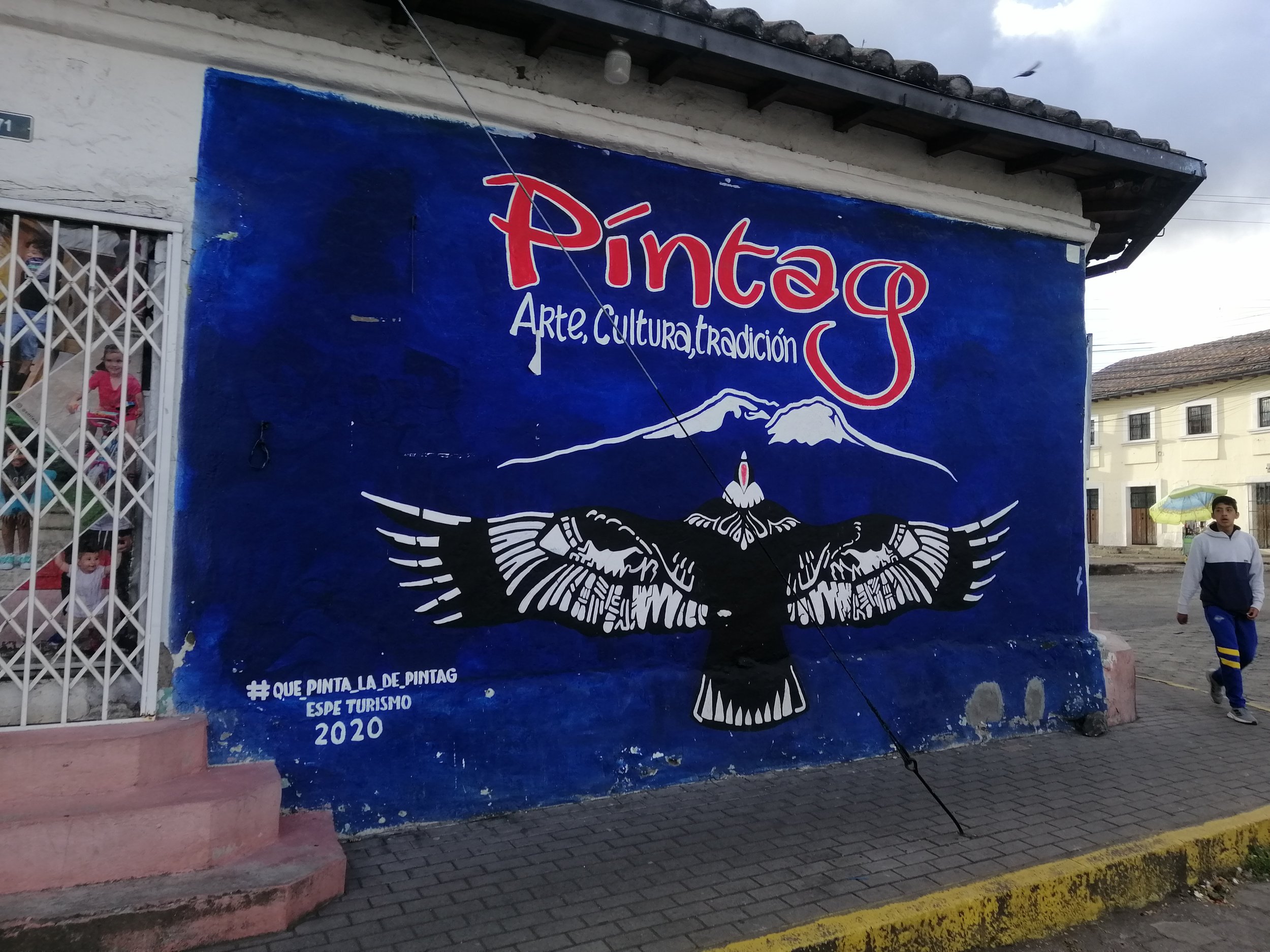
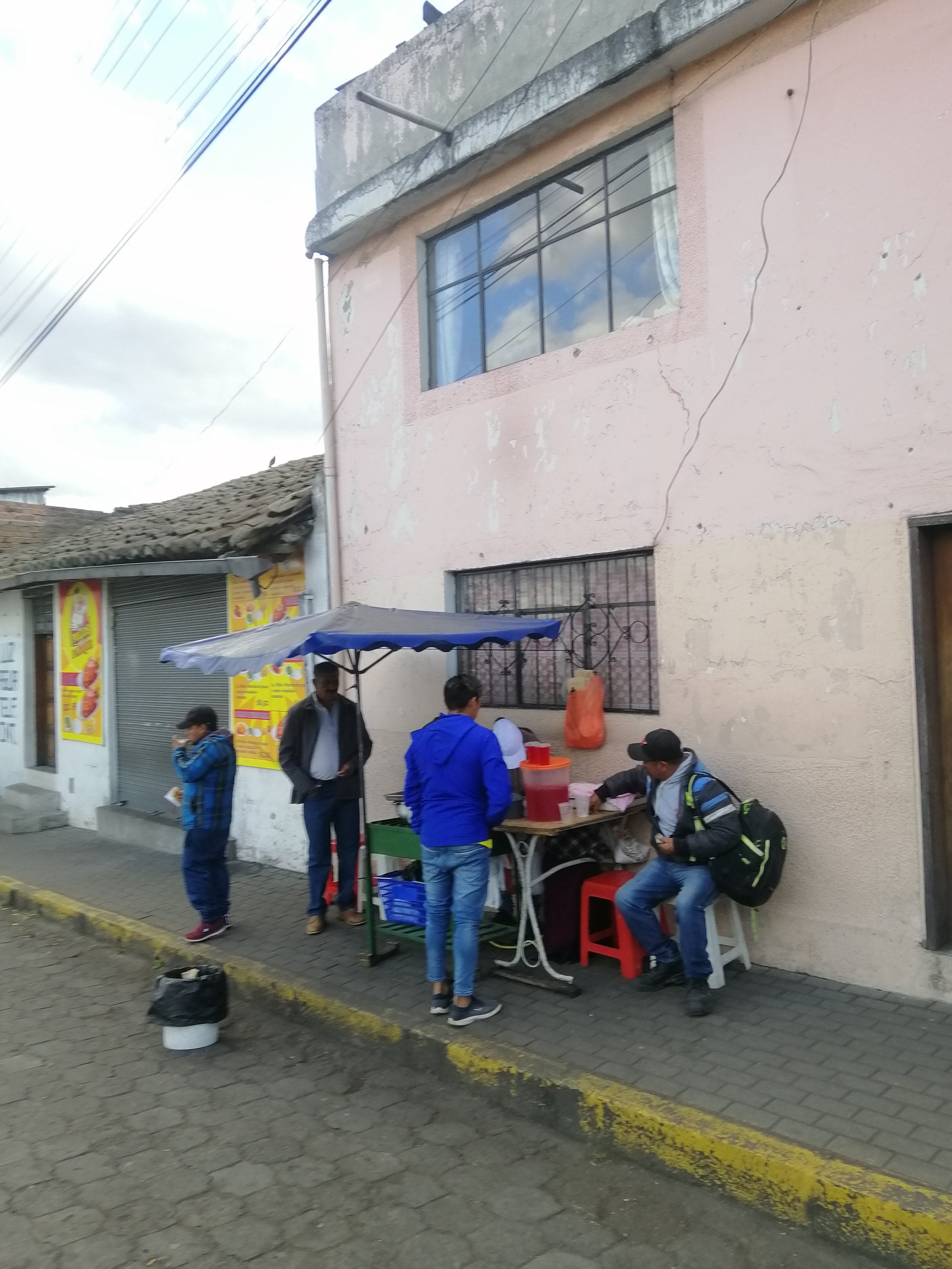
Breakfast of Churrin Churron!
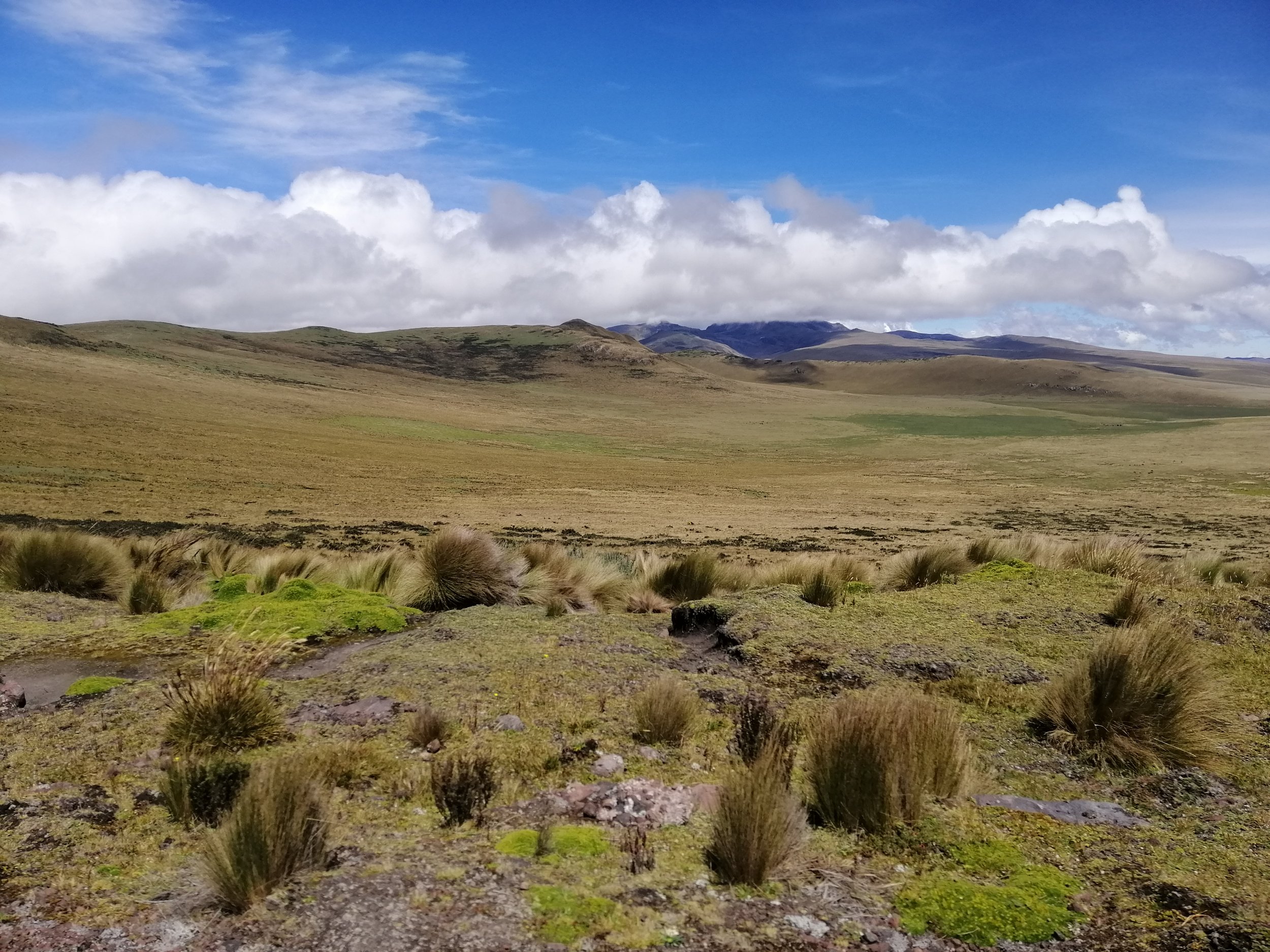
The vast grasslands of Antisana.

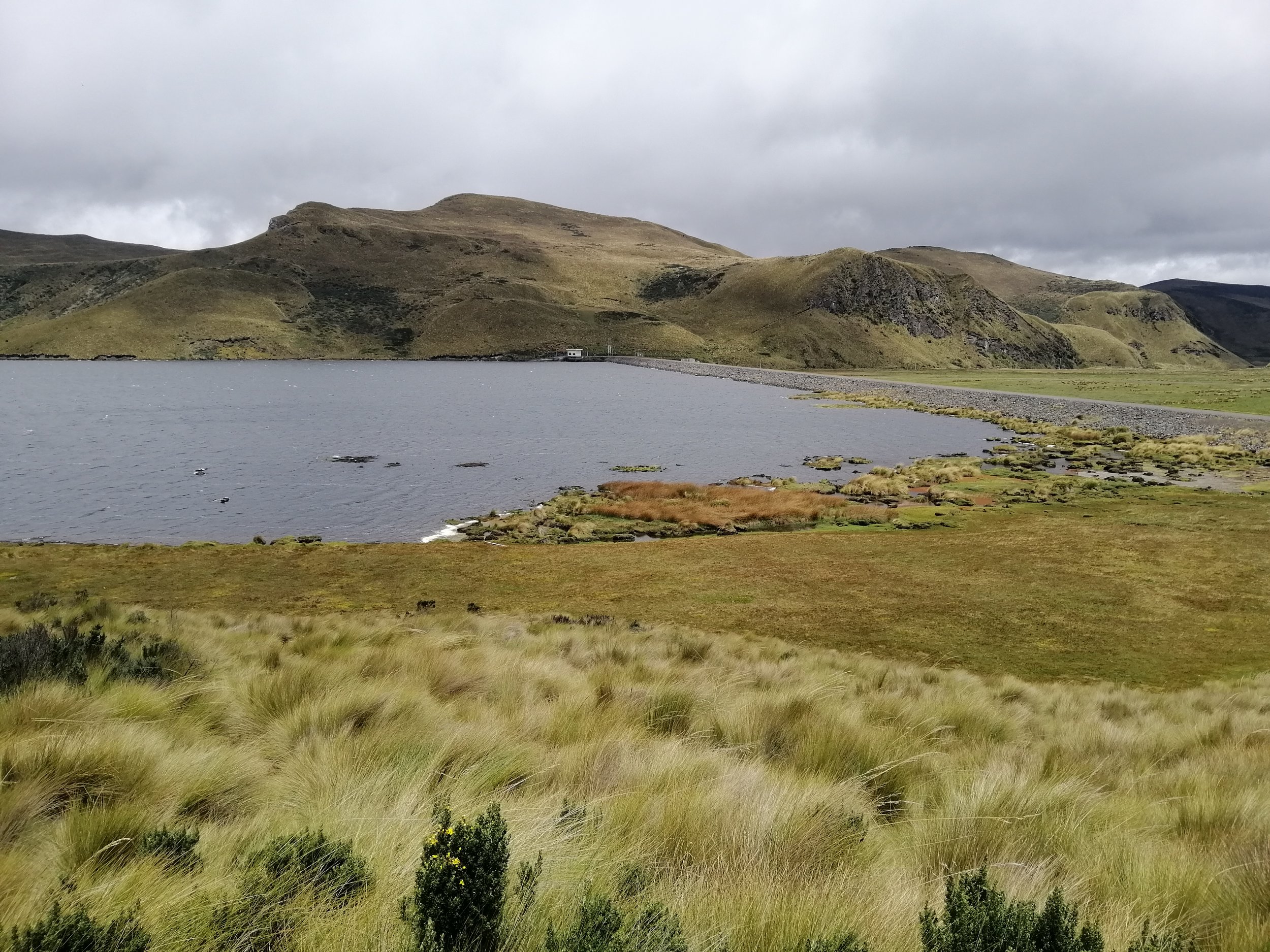

Wetland at Papallacta Summit over 4000m.

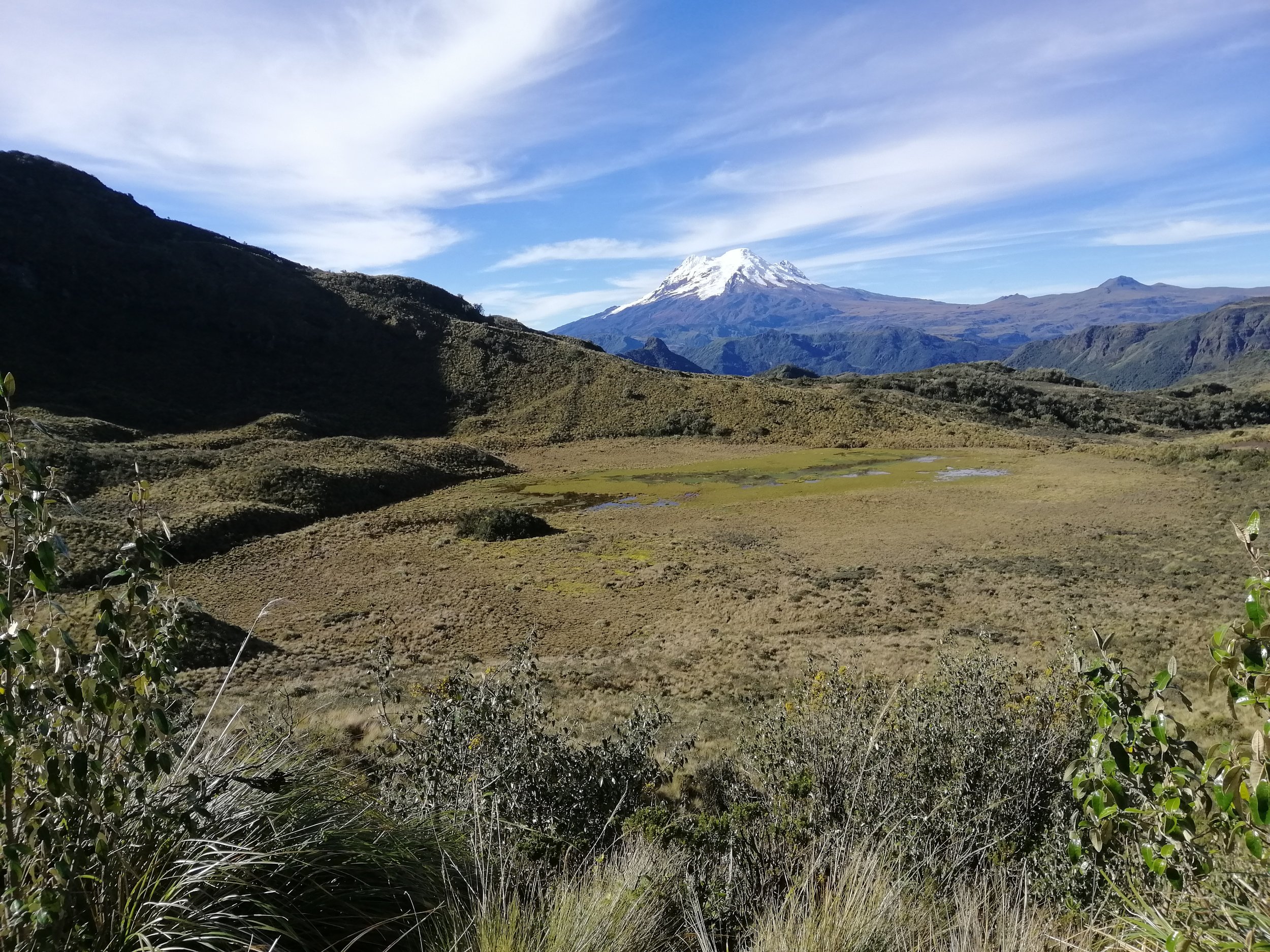
Papallacta Pass & Terma de Papallacta
After some thorough investigation of the Papallacta Pass area, we worked out way down the western slope of the range to Terma de Papallacta, a tourist town famous for hot springs. This is a gorgeous area and we stayed at the hot springs lodge at the end of the road, and it was awesome. Incredible views, pools of varying temperatures and very good cuisine! But our goal was wildlife! Had to keep reminding myself of that…. Although we did not try hard for anymore wildlifing this afternoon, Luis did spot a wonderful Andean Porcupine scurrying around the boardwalk of our resort! We had a great time getting some mediocre images of the little critter.
The next day was spent scouring the slopes of the elfin forest biome of the Western Andes in search of one of my top five targets for the entire expedition – the Mountain or Andean Tapir. The resort staff informed us that one was regularly seen in the grassy slopes of the mountains directly behind the resort. This area was cow pasture even though it abutted Cayambe Coca National Park, so I was a bit surprised and even a bit doubtful that one would frequent such an area, but what the hell did I know….
Searched all morning in vain. Nothing, nothing and nothing again. Although we did see many Andean Tapeti along the road which was a nice lifer for me. Luis suggested we head down to a place he knew that is famous for Tapir sightings – Guango Lodge. This is a very special place for sure. We did find plenty of fresh Tapir sign but no living animal sadly. The lodge is amazing for hummingbirds and other avifauna though and is a well-known stop for birders. Interestingly a birder friend of mine did stop by the lodge a couple weeks after I visited and had excellent sightings of Tapir!
After enjoying a few hours as Guango, we returned to Termas for a bit of a lie-in. Luis did have a network of friends, contacts and family members working on my behalf – the telephone network was very impressive indeed. No sooner than I had laid down for a snooze than I got an excited pounding at the door! It was Luis – “the Tapir is here!” On the road and up the same road we spent this morning fruitlessly, we found Luis’s hermano (also a birding guide) and his birding clients watching a lovely large Andean Mountain Woolly Tapir grazing in the cow pastures on the hill directly in front of us!
I was ecstatic! This was a lifetime goal realized for me. I now had under my belt every single Tapir species on earth seen AND photographed! (Although my Baird’s Tapir pics are pretty lame as I was really not in to photographing much when I saw it in Belize….).
We spent quite a bit of time photographing the Tapir from a distance. We tried to approach a bit closer and succeeded to a degree, but I was happy enough with the sighting even though Nat Geo-quality images were elusive. I was absolutely beside myself.
Link to Birds of Papallacta Pass & Terma de Papallacta & Guango Lodge
Pair of Andean Tapeti along the road to Cayambe Coca NP
Mountain Tapir noting our scent.
Mountain Tapir noting our scent.
Mountain Tapir making visual contact with us.
Mountain Tapir
So cool to see this amazing animal. One of my top lifers of all time!
Andean or Quichua Porcupine (Coendou quichua) Termas Papallacta, Napo near Cayambe Coca National Park
Buff-tailed Coronet were very common at Guango Lodge near Terma
Collared Inca
Long-tailed Sylph
Sword-billed Hummingbird.... I mean, seriously...
Turquoise Jay
San Isidro Lodge
With the success of the day, we turned in early and were on our way the next day to San Isidro Lodge, my final stop on this expedition’s segment in Ecuador. We made a stop at another lodge for birds and a hopeful Black Agouti, both of which were seen but the Agouti was a blur as it saw us before we saw it… San Isidro Lodge, however, has plenty of them and several were scurrying around the feeders pretty much at all times but it does appear that the mornings are best as the insect lights they keep on all night attract moths who are devoured the following mornings by both the birds and the Agouti.
The resort is absolutely spectacular and one night was simply not enough. There is plenty of wildlife around the resort itself, so I didn’t feel too bad that I didn’t have time for exploring a bit further out. At night we were able to follow a lovely family of Grey-bellied Night Monkeys from their nest out for a forage in the canopy. They were a bit challenging to photograph although I was very happy to have seen my first species of Night Monkey finally.
My final day in Ecuador was sad for me. I really wished I had spent more time here. Even though this was my fourth trip to Ecuador I never feel I have enough of this amazing country. I could absolutely live in Ecuador.
As we worked our way back up the Papallactas Pass toward Quito, we continued to search for Northern Pudu and Spectacled Bears but all we got was incredible scenery and that was enough for me. This area of Earth is simply one of the most spectacular places anywhere in the world. I hope to return. But my next stop was Quito International where I was to catch another grueling series of flights that was going to take me to Lima – Santiago – Arica, Chile where I was to begin my Chilean Altiplano of Lauca National Park segment of the Great Primate Safari of 2023!
Black Agouti, my 5th species of Agouti seen in the wild.
Grey-bellied Night Monkey was the main primate target for this trip.
Grey-bellied Night Monkey were seen easily in San Isidro but are not always nesting nearby.
Grey-bellied Night Monkey
Peruvian Racket-tail are something
Gorgeted Woodstar are smaller than your thumb!
Green Jay....Jays are amazing
Black-banded Owl is a nightly visitor to the lodge.
Masked Trogon
Ecuador Species List
(Follow the links below to image galleries of each species)
Link to complete species list for the “Great Primate Safari of 2023”
Order Primates
1. Aotus lemurinus - Grey-bellied Night Monkey - San Isidro Lodge, Ecuador
Family Canidae - Dogs
2. Lycalopex culpaeus - Andean Wolf or Culpeo - Antisana National Park, Eastern Andes Ecuador
Family Cervidae - Deer
3. Odocoileus virginianus ustus - Andean White-tailed Deer - Antisana National Park, Ecuador
Order Lagomorpha - Rabbits
4. Sylvilagus andinus - Andean Tapeti - Termas Papallacta, Napo near Cayambe Coca National Park
Family Mustelidae - Otters
5. Eira barbara - Tayra - Bellavista Cloud Forest Lodge, Ecuador
Family Procyonidae - Raccoons
6. Potos flavus - Kinkajou - Bellavista Cloud Forest Lodge, Ecuador
Order Rodentia
7. Coendou quichua - Andean or Quichua Porcupine - Termas Papallacta
8. Dasyprocta fuliginosa - Black Agouti - San Isidro Lodge, Eastern Andes, Ecuador
9. Dasyprocta punctata - Central American Agouti - Mindo, Ecuador
10. Sciurus granatensis granatensis - Western Red-tailed Squirrel - Bellavista Cloud Forest Lodge
11. Sciurus granatensis chrysuros - Eastern Red-tailed Squirrel - San Isidro Lodge, Ecuador
12. Chilomys percequilloi - Napo Province Papallacta (no images)
Family Tapiridae - Tapirs
13. Tapirus pinchaque - Mountain or Andean Tapir - Termas Papallacta
Family Ursidae - Bears
14. Tremarctos ornatus - Spectacled Bear - Bellavista Cloud Forest Lodge, Ecuador







































































